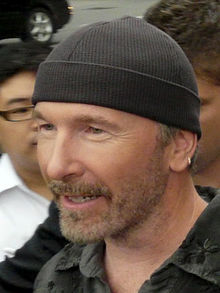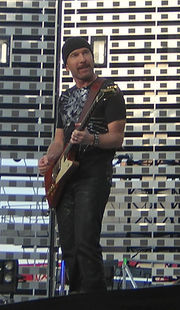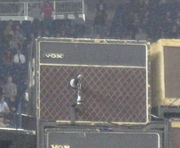The Edge
| The Edge | |
|---|---|
 |
|
| Background information | |
| Birth name | David Howell Evans |
| Born | 8 August 1961 Barking, London, England |
| Origin | Dublin, Ireland |
| Genres | Rock, post-punk, alternative rock |
| Occupations | musician, songwriter, activist |
| Instruments | guitar, keyboards, vocals, bass guitar |
| Years active | 1976–present |
| Labels | Island (1980–2006) Mercury (2006–present) |
| Associated acts | U2, Passengers |
| Website | U2.com |
| Notable instruments | |
| Gibson Explorer Fender Stratocaster Gibson Les Paul Fender Telecaster Epiphone Casino Gretsch Country Gentleman Rickenbacker 330/12 |
|
David Howell Evans (born 8 August 1961 in Barking, Essex, England), more widely known by his stage name The Edge (or just Edge),[1] is an British-born Irish musician best known as the guitarist, keyboardist, and main backing vocalist of rock band U2. His distinctive electric guitar timbre and percussive style of playing, along with his use of digital sound processing — delay and chorus in particular — have been crucial in defining U2's sound. In 2003, Rolling Stone magazine named him at #24 on its list of "The 100 Greatest Guitarists of All Time".
Contents |
Personal life
David Howell Evans was born at the Barking Maternity Hospital,[2] Essex, England to Welsh parents Garvin and Gwenda Evans.[3] When he was just one, his family moved to County Dublin, Ireland where he attended St. Andrew's National School. He received piano and guitar lessons and often performed with his brother Dik Evans before they both answered an advertisement posted by Larry Mullen, Jr. at their school, Mount Temple Comprehensive School, seeking musicians to form a band.[4] The band accepted both of them. This band went through several incarnations before emerging as U2 in March 1978 (Dik Evans left the band just before the name change[5]). U2 began performing in various venues in Ireland and eventually began developing a following. Their debut album, Boy, was released in 1980.
In 1981, leading up to the October tour, Evans came very close to leaving U2 for religious reasons, but he was persuaded to stay.[4] During this period, he became involved with a group called Shalom Tigers, in which bandmates Bono and Larry Mullen Jr. were also involved.[6] Shortly after deciding to remain with the band, he wrote a piece of music that later became "Sunday Bloody Sunday".[4] The Edge married his high school girlfriend Aislinn O'Sullivan on 12 July 1983.[7] The couple had three daughters together: Hollie in 1984, Arran in 1985 and Blue Angel in 1989.[6] The couple separated in 1990, but were unable to get officially divorced because of Irish laws regarding marriage annulment; divorce was legalised in 1995 and the couple were legally divorced in 1996.[6]
During U2's Zoo TV Tour, The Edge began to date Morleigh Steinberg, a professional dancer and choreographer employed by the band as a belly dancer for the tour's live performances. The couple began dating in 1993, and had their daughter, Sian, in 1997, and a son, Levi, (25 October 1999).[6] They were married on 22 June 2002.[6]
He appeared in the 2009 music documentary film It Might Get Loud.[8] He is also a Methodist Christian.
Music
"Notes actually do mean something. They have power. I think of notes as being expensive. You don't just throw them around. I find the ones that do the best job and that's what I use. I suppose I'm a minimalist instinctively. I don't like to be inefficient if I can get away with it. Like on the end of "With or Without You". My instinct was to go with something very simple. Everyone else said, 'Nah, you can't do that.' I won the argument and I still think it's sort of brave, because the end of "With or Without You" could have been so much bigger, so much more of a climax, but there's this power to it which I think is even more potent because it's held back... ultimately I'm interested in music. I'm a musician. I'm not a gunslinger. That's the difference between what I do and what a lot of guitar heroes do."
Guitar playing
As a guitar player, The Edge is recognized as having a trademark sound typified by a low-key playing style, a chiming, shimmering sound (thanks in part to the signature sound of classic VOX AC-30s) that is achieved with extensive use of delay effects, reverb, and a focus on texture and melody. To achieve an "Edge-like" sound, the feedback delay is set to a dotted eighth note (3/16 of a measure), and the feedback gain is adjusted until a note played repeats two or three times.
1987's The Joshua Tree is probably the best example of the "U2 sound", with songs such as "With or Without You" and "Where the Streets Have No Name" being among the band's most critically acclaimed and best loved works. The album showcases The Edge's approach to the guitar: rather than trying to push his guitar to the front of the mix and make his contributions obvious, The Edge focuses on the song and the mood, often contributing just a few simple lead lines given depth and richness by an ever-present digital delay. For example, the introduction to "Where the Streets Have No Name" is simply a repeated six-note arpeggio, broadened by a modulated delay effect. The Edge has said that he views musical notes as "expensive", in that he prefers to play as few notes as possible. He said in 1982 of his style,
"I like a nice ringing sound on guitar, and most of my chords I find two strings and make them ring the same note, so it's almost like a 12-string sound. So for E I might play a B, E, E and B and make it ring. It works very well with the Gibson Explorer. It's funny because the bass end of the Explorer was so awful that I used to stay away from the low strings, and a lot of the chords I played were very trebly, on the first four, or even three strings. I discovered that through using this one area of the fretboard I was developing a very stylized way of doing something that someone else would play in a normal way."[10]

The Edge's guitar technique has been shaped by many different influences. His first guitar was an old acoustic guitar that his mother bought him at a local flea market for only a few pounds, he was nine at the time. His brother Dik Evans and he experimented.[10] He said in 1982 of this early experimentation, "I suppose the first link in the chain was a visit to the local jumble sale where I purchased a guitar for a pound. That was my first instrument. It was an acoustic guitar and me and my elder brother Dik both played it, plonking away, all very rudimentary stuff, open chords and all that."[10]
The Edge has stated that many of his guitar parts are based around guitar effects. This is especially true from the Achtung Baby era onwards, although much of the band's 1980s material made heavy use of echos. His influence as a guitarist can be heard by acts such as Radiohead, Muse, Coldplay, and other bands of the alternative scene.
Vocals
The Edge also supplies the backing vocals for U2. U2's 1983 live album and video release, Under a Blood Red Sky and Live at Red Rocks: Under a Blood Red Sky are good reference points for his singing (as are the live DVDs from the Elevation Tour, U2 Go Home: Live from Slane Castle and Elevation 2001: Live from Boston). For example, he sings the chorus to "Sunday Bloody Sunday" (Bono harmonizes on the final 'Sunday'). U2 used this tradeoff technique later in "Bullet the Blue Sky" as well. His backing vocals are often in the form of a repeated cry. Examples of songs that use this approach include "Beautiful Day" and "New Year's Day". The Edge sings the lead vocal on "Van Diemen's Land" and "Numb", the first half of the song "Seconds", dual vocals with Bono in "Discotheque", and the bridge in the song "Miracle Drug".[6] His backing vocals are often in falsetto, such as "Stuck in a Moment You Can't Get Out Of", "Sometimes You Can't Make It on Your Own", "The Wanderer", live versions of "The Fly", and "Window in the Skies". He also sings the occasional lead vocal in live renditions of other songs (such as "Sunday Bloody Sunday" during the PopMart Tour and "Party Girl" during the Rotterdam Zoo TV show when it was Bono's birthday[11]).
Other instruments
He has played piano and keyboards on many of the band's songs, including "I Fall Down", "October", "So Cruel", "New Year's Day", "Running to Stand Still", "Miss Sarajevo", "The Hands that Built America", and "Original of the Species" and others. He plays the organ on "Please". In live versions of "New Year's Day", "The Unforgettable Fire", "Your Blue Room", and "Moment of Surrender", he plays both the piano and guitar parts alternately. In most live versions of "Original of the Species," piano is the only instrument played during the song.
Although The Edge is the band's lead guitarist, he occasionally plays bass guitar, including the live performances of the song "40" where The Edge and bassist Adam Clayton switch instruments.
Solo recordings
In addition to his regular role within U2, The Edge has also recorded with such artists as Johnny Cash, B. B. King, Tina Turner, Ronnie Wood, Jay-Z, and Rihanna.
The Edge connected with Brian Eno and Lanois collaborator Michael Brook (the creator of the infinite guitar, which he regularly uses), working with him on the score to the film Captive (1986). From this soundtrack the song "Heroine", the vocal of which was sung by a young Sinéad O'Connor was released as a single.
He also created the theme song for Season 1 and 2 of The Batman.
He and fellow U2 member, Bono, wrote the lyrics to the theme of the 1995 James Bond film GoldenEye.
Musical equipment
The Edge plays electric guitar, acoustic guitar, keyboards, piano, bass guitar (on "40" and "Race Against Time") and lap steel guitar.
Compared to many lead guitarists, The Edge is known for using many more guitars during a show. According to his guitar tech Dallas Schoo, a typical lead guitarist uses four or five different guitars in one night, whereas The Edge takes 45 on the road, and uses 17 to 19 in one 2.5-hour concert. He is estimated to have more than 200 guitars in the studio.
Guitars
|
Keyboards |
When he takes over for bassist Adam Clayton for the song "40", he used the Ibanez Musicia n in the 1980s and the Lakland Darryl Jones Signature for the more recent Vertigo Tour.
Amps

- Vox AC30 – his 1964 AC30 top boost has been used to record every single U2 album and has been used for every single concert. He has said in interviews that he owns over thirty AC30's.
- Fender Deluxe Tweed – 1956 with Vox speaker
- Fender Deluxe Tweed – 1958 with Jensen Alnico speaker
- Fender Blues Jr
- Roland JC120
Pedals and rack
Floorboard
- Boss FV-300L volume pedal
- Dunlop Cry Baby
- Digitech Whammy WH-1
- BOSS TU-2 Tuner
- Skrydstrup SC-1 (foot controller which controls the gear in rack, and the pedals as well.)
Pedals
- Lovetone Meatball
- Lovetone Doppelganger
- Electro-Harmonix Big Muff PI
- Electro-Harmonix POG
- Ampeg Scrambler
- Ibanez TS-9 Tube Screamer
- MXR Dyna Comp
- Death By Audio Supersonic Fuzz Gun
- Digitech Synth Wah
- BOSS GE-7 Graphic Equalizer
- BOSS CS-2 Compressor/Sustainer
- BOSS PW-2 Power Driver
- BOSS FA-1 FET Amplifier
- Skrydstrup Bufferooster
- Sobbat DB-1 Drive Breaker : Japanese boutique pedal, used for the outro of "Until The End Of The World"
- Kay Fuzz: effect was removed from its plastic case and built inside an empty Crybaby housing. Used for the intro of "Elevation"
Rack
- Lexicon PCM (x2)
- Line6 DM4 Rackmounted Distortion Modeler (x2) (Custom Made)
- TC 2290 Dynamic Delay (x4; two are placed before the POD effects, two of them placed afterwards)
- Line 6 Pod Pro
- Korg SDD 3000
- Korg A3
- Eventide Ultra-Harmonizer
- AMS S-DMX
- Rocktron DVC Volume Controller
- Electrix Filter Factory
Philanthropy
In 2005 The Edge along with Bob Ezrin and Henry Juszkiewicz co-founded Music Rising, a charity that helped provide replacement instruments for those that were lost in Hurricane Katrina. The instruments were originally only replaced for professional musicians but they soon realized the community churches and schools needed instruments as well. The charity's slogan is “Rebuilding the Gulf Region note by note” and has so far helped over a hundred musicians who were affected by Hurricane Katrina. The Edge also serves on the board of the Angiogenesis Foundation, a 501(c)(3) nonprofit organization dedicated to improving global health by advancing angiogenesis-based medicine, diets, and lifestyle.[12]
See also
- List of people on stamps of Ireland
- Timeline of U2
References
- ↑ U2 Limited (2006). U2 by U2. London: HarperCollinsPublishers, 21. ISBN 0-00-719668-7
- ↑ Unforgettable Fire: The Story of U2. London: Penguin Books. 1988. p. 70. ISBN 0-14-010766-5.
- ↑ U2 Limited (2006). U2 by U2. London: HarperCollinsPublishers. p. 21. ISBN 0-00-719668-7.
- ↑ 4.0 4.1 4.2 U2; McCormick, N. (26 September 2006). U2 by U2. New York: Harper Collins Publishers. pp. 117–120. ISBN 0-06-077675-7.
- ↑ U2 Limited (2006). U2 by U2. London: HarperCollinsPublishers, 117–120. ISBN 0-00-719668-7
- ↑ 6.0 6.1 6.2 6.3 6.4 6.5 "The Edge biography (@U2)". http://www.atu2.com/band/edge/. Retrieved 9 September 2007.
- ↑ U2 Limited (2006). U2 by U2. London: HarperCollinsPublishers. p. 144. ISBN 0-00-719668-7.
- ↑ "IT MIGHT GET LOUD". http://www.sonyclassics.com/itmightgetloud/. Retrieved 20 March 2010.
- ↑ Flanagan, Bill (1995). U2 at the End of the World. Delacorte Press. p.43. ISBN 0-385-31154-0
- ↑ 10.0 10.1 10.2 "On the Edge of Success". U2 Magazine No. 3. 1 May 1982. http://u2_interviews.tripod.com/id16.html. Retrieved 6 November 2007.
- ↑ U2 Rotterdam, 10 May 1993, Feyenoord Stadium, ZOO TV Tour – U2 on tour
- ↑ The Angiogenesis Foundation: People http://www.angio.org/about-people-bod.php, Retrieved 12/7/2009
External links
- U2.com, official U2 site
- Music Rising
- The Edge at the Internet Movie Database
- The Edge – Album Credits
- A Study of The Edge's Guitar Delay
- The Edge: 'It's all about the vision'
- Food Bank For New York City public service announcement
- Comment on the mathematical analysis of The Edge's guitar sound
|
|||||||||||||||||||||||||||||
|
|||||||||||